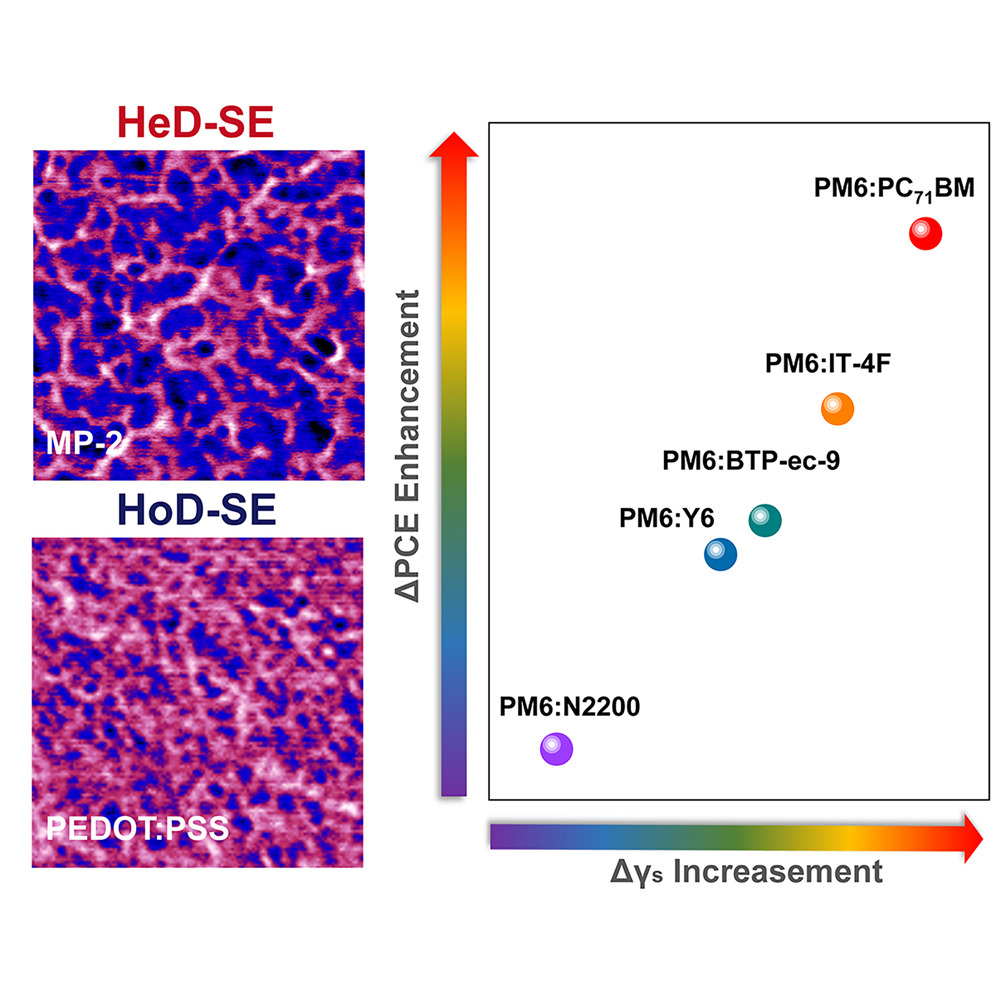博文
中美研究人员提出了有机太阳能电池界面改性的新策略
||
中美研究人员提出了有机太阳能电池界面改性的新策略
诸平
Graphical abstract. Credit: DOI: 10.1016/j.joule.2021.09.001
据中国科学院(Chinese Academy of Sciences简称CAS)2021年10月15日提供的消息,中美研究人员提出了有机太阳能电池界面改性的新策略(Researchers propose new strategy for interfacial modification of organic solar cells)。
表面能(γs)在溶液法制备有机太阳能电池体异质结(bulk-heterojunction简称BHJ)膜形成过程中起着关键作用。通过施主和受主表面能的差异可以预测BHJ薄膜的混溶性。底层界面层的表面能可以调节BHJ薄膜的垂直分布和堆积方向。薄膜的表面能通常是通过欧文斯-温特模型(Owens-Wendt model)测量接触角得到的。
然而,这种测量方法不能反映纳米尺度范围内的表面能分布(surface energy distribution),也不能直接解释BHJ结构中的纳米级堆积和相分离。最近,一个由中国科学院国家纳米科学中心(National Center for Nanoscience and Technology简称NCNST) 周惠琼(Zhou Huiqiong音译)教授、裘晓辉(Qiu Xiaohui音译)教授、张勇(Zhang Yong音译)教授领导的研究小组,提出了一种研究有机太阳能电池界面层纳米尺度表面能分布规律的新策略。相关研究结果于2021年9月28日已经在在《焦耳》(Joule)杂志网站发表——Yanxun Li, Jianwei Ding, Cheng Liang, Xuning Zhang, Jianqi Zhang, Devon S. Jakob, Boxin Wang, Xing Li, Hong Zhang, Lina Li, Yingguo Yang, Guangjie Zhang, Xiaoxian Zhang, Wenna Du, Xinfeng Liu, Yuan Zhang, Yong Zhang, Xiaoji Xu, Xiaohui Qiu, Huiqiong Zhou. Nanoscale heterogeneous distribution of surface energy at interlayers in organic bulk-heterojunction solar cells. Joule, (2021). DOI: 10.1016/j.joule.2021.09.001. Published: September 28, 2021. https://doi.org/10.1016/j.joule.2021.09.001
参与此项研究的有来自中国国家纳米科学中心中国科学院卓越纳米科学中心(CAS Center for Excellence in Nanoscience, National Center for Nanoscience and Technology)、北京航空航天大学化学学院、北京生物医学工程先进创新中心(School of Chemistry, Beijing Advanced Innovation Center for Biomedical Engineering, Beihang University),美国利哈伊大学化学系(Department of Chemistry, Lehigh University, USA)、中国科学院上海高等研究院张江实验室同步辐射装置(Shanghai Synchrotron Radiation Facility (SSRF), Zhangjiang Lab, Shanghai Advanced Research Institute, Chinese Academy of Sciences)以及中国科学院大学(University of Chinese Academy of Sciences, Beijing)的研究人员。
研究人员使用基于原子力显微镜(AFM)的峰力定量纳米力学映射(Peak-Force Quantitative Nanomechanical Mappings简称PFQNM)技术来表征有机太阳能电池中空穴传输层的纳米级表面能量分布。他们发现,不同横向尺寸的掺杂MoS2纳米片可以有效调节聚3,4 -乙二氧基噻吩(poly 3, 4-ethylenedioxythiophene):聚苯乙烯磺酸盐(polystyrene sulfonate, PEDOT : PSS)的表面能分布,扩大了PEDOT:PSS分布的异质性(heterogeneity)。表面能的非均匀分布(heterogeneous distribution of surface energy简称HeD-SE)能够进一步调节了活性层的分子分布、晶体取向和相分离。
由于HeD-SE对活性层形貌的优化,有机太阳能电池的性能和稳定性得到了提高,最佳功率转换效率(power conversion efficiency简称PCE)为18.27%。另外,PCE的增强率与BHJ中Δγs的增大成正比。
周惠琼的团队一直致力于溶液处理有机太阳能电池(organic solar cells)的界面操纵,并开展了一系列有机太阳能电池表面能量调节的研究。通过在PEDOT:PSS中加入WOx纳米颗粒,首次在有机太阳能电池中实现了80%的高填充系数(a high fill factor of 80%)。然后他们探索了活性层的堆积取向与有机太阳能电池的性能以及界面层的表面能之间的关系( the relationships between the stacking orientation of the active layer, the performance of organic solar cells and the surface energy of the interface layer)。采用界面改性的方法研究了倒置器件的电子传输层,并在钙钛矿太阳能电池(perovskite solar cells)中得到了应用。利用生物聚合物肝素钠(heparin sodium)修饰钙钛矿太阳能电池的表面能,对其界面缺陷进行了钝化处理,提高了PCE和稳定性。
上述介绍,仅供参考。欲了解更多信息,敬请注意浏览原文或者相关报道。
•The nanoscale distribution of γs is modulated by 2D MoS2 nanosheets
•The morphologies of BHJs are successfully optimized by the nanoscale HeD-SE of HTLs
•The correlations between the BHJ morphology, OSCs performance, and HeD-SE are explored
•A best PCE of 18.27% with certified efficiency of 17.80% in binary BHJ OSCs was achieved
Solution-processed organic bulk-heterojunction (BHJ) solar cells (OSCs) show unique advantages in light weight, mechanical flexibility, and low-cost production. The morphology at the nanoscale of BHJ active layers determines exciton and charge carrier behaviors in the devices, which could be regulated by the surface energy (γs) of the underlying interlayers. However, the parameter γs is commonly calculated by contact angle (CA) measurements and cannot describe whether the interfacial state is homogeneous or heterogeneous at the nanoscale. Here, we demonstrate an effective strategy to modulate the nanoscale distribution of surface energy at interlayers, which is characterized by a peak force quantitative nanomechanical mapping mode based on atomic force microscopy. The composite distribution, molecular stacking, and phase separation of BHJs are favorably regulated by the nanoscale heterogeneous distribution of surface energy at interlayers, leading to a best PCE of 18.27% and a certified efficiency of 17.80%.
Surface energy of the underneath interlayer plays a crucial role in determining the morphology of bulk-heterojunction (BHJ) film in solution-processed organic solar cells (OSCs). However, little attention has been paid to this perspective at the microscopic level. In this study, we demonstrate an effective strategy to tune thenanoscale heterogeneous distribution of surface energy (HeD-SE) at interlayers through incorporating two-dimensional (2D) MoS2 nanosheets, which modulate the component distribution, molecular orientation, and phase separation in the upper BHJ layers, leading to suppressed charge recombination and increased charge extraction in devices with enhanced power conversion efficiency (PCE) and device stability. Furthermore, we explore the relationship among the different surface energies of BHJs between the donor and the acceptor, the nanoscale HeD-SE at interlayers, and the PCEs of the resultant devices. This work reveals the impact of nanoscale heterogeneity in the distribution of surface energy in the underneath interlayers on the BHJ morphology and device performance in OSCs.
https://blog.sciencenet.cn/blog-212210-1308110.html
上一篇:表面化学揭示了腐蚀的秘密
下一篇:无线电波能冷却到量子基态?
